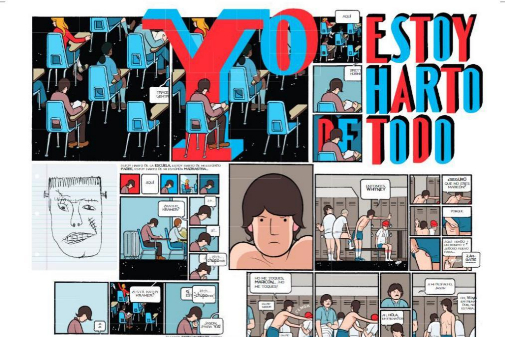- Interview. "I am an atheist, but I believe in forgiveness ... less for Hitler"
Someone who dedicates 16 years - an entire adolescence - to drawing a comic can only be a genius, a madman or Chris Ware . The cartoonist in his fifties in Nebraska must be imagined in his studio, leaving his eyelashes night after night in front of the computer, watching the sunlight bounce off the walls like Antonio López's good or attending the window to change the seasons in timelapse , while the world forgot a little about him.
Well, the result of such an inversion of time, of such an example of constancy in this post-era era , is entitled Rusty Brown. It was published in Spain at the beginning of November (Reservoir Books) and since then it has not stopped receiving warm and even bombastic words.
Because the truth is that Rusty Brown is not (exactly) a comic: it is the culmination of a career . That of an enigmatic artist, perfectionist, overwhelming, dribbler, unrepeatable. A fantasist who is revered, and rightly so, as the undisputed master of the experimental graphic novel. Or said more mundanely: the guy who has made the cartoons equally interest an anonymous pipe eater and a curator .
Among his achievements are, for example: 1) The reinvention of the page (from a kaleidoscope showcase); 2) The almost allergic rejection of linear narration; 3) The grafting of typographic games; 4) The predilection for flat colors; 5) The use of any printing product -poster, brochure, board game board ...- as a complementary corpus of the main device; and 6) The sublimation of melancholy as the emotional temperature of the West.
In short, Ware is recognized for having resized the conception of the comic towards the artistic , and its ability to produce artifact books to which Duchamp himself could only have clapped.
Rusty Brown , which weighs 360 pages, responds to all this, and as a total work he did not have it easy after his predecessors - Jimmy Corrigan, the smartest boy in the world (2016) and Making stories (2014) - made criticism specialized would get on his knees such that before the Second Advent.
Described as a "time machine on pictogly paper," Rusty Brown travels the lives of several characters joined by an American Midwest school. Ware shows the fears and obsessions of a teacher, an abuser or a child with super powers as if psychoanalyzing her community of neighbors.
"For both the reader and the artist, the comics are already a kind of paper mirror, " said the author of this overflight flyer, similar to the one Ibáñez made in his legendary 13, Rue del Percebe with the impulse of costumbrismo cañí.
It is still curious that Ware has many more awards than published titles. That he has bothered to find out how many trips to and from the Sun could be made if we unroll and stretch the DNA of a human being (70) or that he recognizes that among his favorite books is War and Peace they speak of his obsessive personality and hungry for challenges .
The New Yorker regular portadist and author in 2010 of a cover for Fortune that the magazine did not dare to send to the press - portrayed several drunken CEOs dancing on skyscraper terraces in their special number on the 500 largest US companies -, Ware can only be asked to publish more. Or that it doesn't take long to do so.
MERY CUESTA
1. Rusty Brown (Reservoir Books), by Chris Ware.
2. The divine comedy by Oscar Wilde (Astiberri), by Javier de Isusi.
3. Clyde (Salamandra) fans , from Seth.
4. Bezimena "(Reservoir Books). By Nina Bunjevac.
5. In a ray of the sun (The Dome), Tillie Walden.
LUIS ALBERTO DE CUENCA
1. Hope despite everything. An adventure of Spirou (Dibbuks), by Émile Bravo.
2. Modotti. Corrected and augmented edition (Kingdom of Cordelia), by Ángel de la Calle.
3. The daughter of Vercingetórix. An adventure of Astérix (Salvat), of Didier Conrad (drawings) and Jean-Yves Ferri (script).
4. Integral of Brian the Brain (Kingdom of Cordelia), by Miguel Ángel Martín.
5. Imaginary lives of Schwob (Lights of Gauge), by Laura Pérez Vernetti.
FELIPE HDEZ. DIGGING
1. The ages of the rat (Salamandra), by Martín López Lam.
2. Rusty Brown ', (Random House), by Chris Ware.
3. God, man, eat and two or three other things (Lumen), from Tute.
4. Clyde (Salamandra) fans , from Seth.
5. The singing of aglae (The Dome), by Anne Simons.
According to the criteria of The Trust Project
Know more- culture
- comic
Culture Low culture spending in Spanish households by 5%
Literature Interrogations, threats and murders: the true story behind 'The Irish'
The Paper SphereMaría Moreno, a way of being wild

